The Synthesizer magazine Synmag is a special-interest magazine focusing on technical and musical innovations. It was founded in 2006 by Andreas Michel and Moogulator in Solingen and Rellingen near Hamburg. It is dedicated to everything the name promises.
In the february / march issue, Andreas from Playlist-Promotion.com was asked about Playlist Pitching on Spotify.
We translated the interview into English for you, read it below.
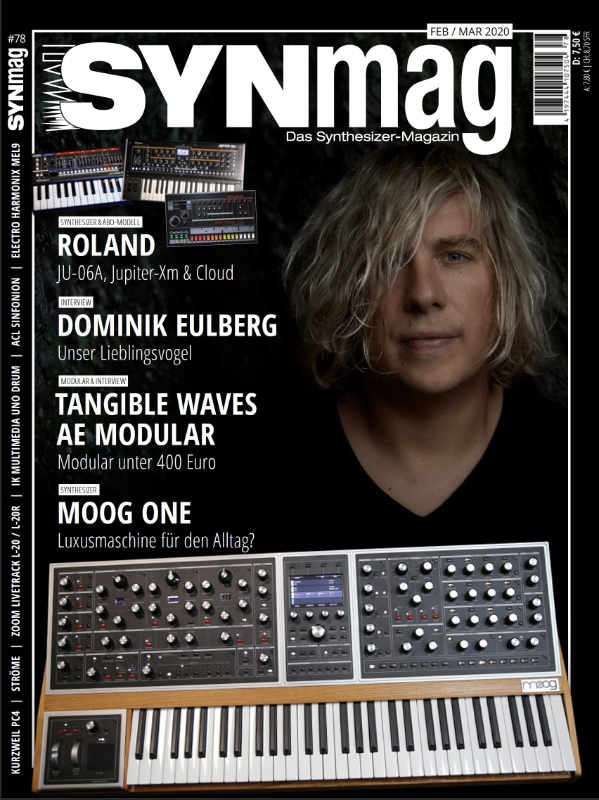
The service provider Playlist-Promotion.com offers independent and major artists to place songs on successful playlists within Spotify. Youtube promotion is also offered. Both should enable newcomers to reach a large audience quickly.
The provider, which has its headquarters in Munich, promises “real Spotify promotion“, so to say real streaming coverage – no fake-plays by bots or hacked accounts as some service providers do.
We have spoken with company co-founder Andreas Klein.
Your Playlist Promotion company was founded in 2014 – how did the business model develop?
We originally started our music promotion business in 2004 with our then company “,We Run This”, specifically aimed at American hip hop artists who wanted to gain a foothold in Europe. Among our customers were T. I., Jadakiss, who had the hit „Jenny From the Block” with Jennifer Lopez, Mobb Deep or Talib Kweli. At that time we worked with European magazines, organized interviews and distributed compilation CDs with the artists. For artist marketing we used EMail newsletters, forum and blog promotion. The songs were first attached to mails, later links were sent, the email-plays were directed to American and European DJs. Then we moved on to the booking area and brought US artists, for whom we had done the DJ sampling, to Germany for shows. In 2014 we specialized in Spotify playlist promotion. Since then we offer this playlist service for national and international artists.
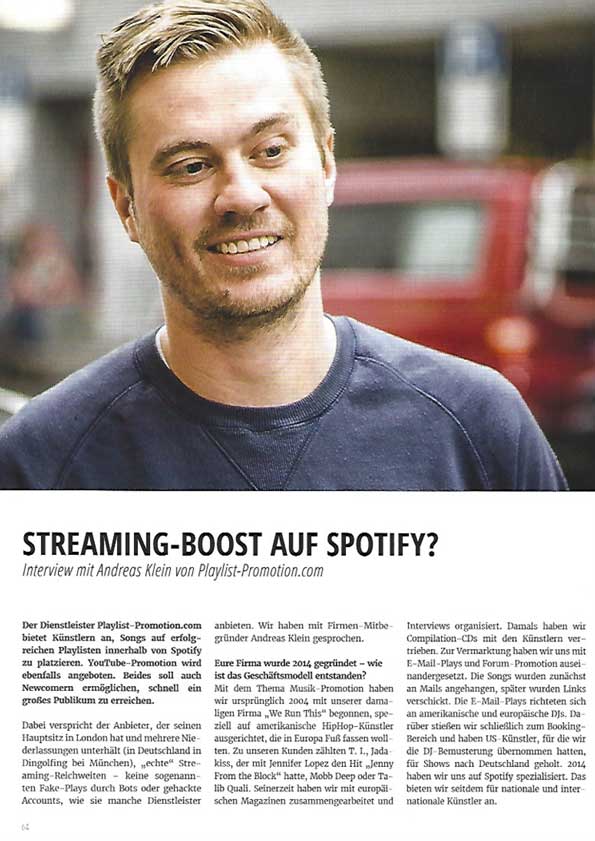
What made you specialize in Spotify placements?
We first offered and promoted the compilations as CDs, later as downloads. iTunes was the market leader with downloads at the beginning, in 2015 streaming via Spotify gained market share. We saw potential in this, as Spotify is very well suited to address a targeted audience via playlists. We tried this out with customers and expanded the topic. Our team has now grown – there are six of us. Our Spotify promo company was one of the first on the market to offer targeted promotion on Spotify, and we also have the largest database. Ninety percent of all playlists that exist on spotify we have captured and are in contact with the operators to place songs there. Independent playlists – those that are not operated by record companies – exist 5000. In our database there are about 3.000.
As an artist, how can I imagine your Spotify promotion service to place a song on playlists?
We listen to the song and decide whether we can work with the song, place it. We have a lot of playlists, but we guarantee placements. In order to guarantee that, we have to select. The production quality plays a role. We reject recordings that overdrive. We even get requests where the musicians have recorded the songs with their mobile phones: Studio quality should be there. The voice should be clear without sinking into reverberation, if it is not stylistically desired. In addition, there is the genre: We don’t work in the classical, blues or jazz genre, because the market at Spotify is too small there, with only a few playlists. Our packages start at the range of 100.000 playlist followers. This means that we would have to place a song on ten playlists with 10,000 followers each, for example. The largest package has a two million follower range. Then we place the song on 40 to 80 correspondingly large playlists. We only place the songs on genre-typical playlists or those that match the mood: A summery hip hop song will fit on summer playlists, but not on a rock or electro playlist. Some promotion companies do it anyway.
Don’t followers of a playlist also jump off if it doesn’t keep its promises?
This can happen, so we regularly check the playlists we use. There are Curator’s playlist owners – who only take self-selected music. Some of them have a good number of followers. Others take everything that is suggested to them. Over time, they have lost followers as well. If you follow the playlists over years, ‘you can see if someone has bought followers, what is offered on the net. Larger jumps from 2,000 to 5,000 followers within seven days seem suspicious. These playlists fall out of our system. We try to place the music on quality playlists so that customers get as many streams and followers as possible. The final streams cannot be predicted, but with the smallest package with 100,000 followers, the artist can usually expect at least 20,000 streams. The number can also increase fivefold. We also offer a money-back guarantee if we can’t fulfill all playlist placements, and will refund the missing portion. Due to our large playlist database, this has only happened once so far, on an experimental song we had accepted. It’s important to us to offer a complete package that not only simply streams, but helps the artist and generates new fans who then listen to songs in his profile. Happy customers will come back to us later. Every company lives from regular customers, we also attach importance to that. We have customers from all over the world, so we work in an American time zone. Most of our customers come from North America and Canada, but we also have customers from South Korea: We promoted the most famous K-Pop band, BTS, with their song “Singularity”. On Spotify, the band has about 15 monthly listeners.
I can’t name the American names, but among them are artists from the Top 10 of the Hip Hop and Top 20 of the Pop Charts. One of the most famous hip hop artists is a regular customer of ours. We also work together with major labels.
How has the Spotify market changed over the years?
When we started, the playlist market was quite manageable, a fraction of today’s.
At that time there were no giant playlists. A big one had maybe 20,000 followers. The biggest playlist in our database today has over a million followers – the biggest independent playlist on Spotify. For almost two years now, fake-plays have become popular with artists, plus fake-playlists. This is not good for the market, because new customers are sceptical at the beginning:. Are these really real playlists with real followers?
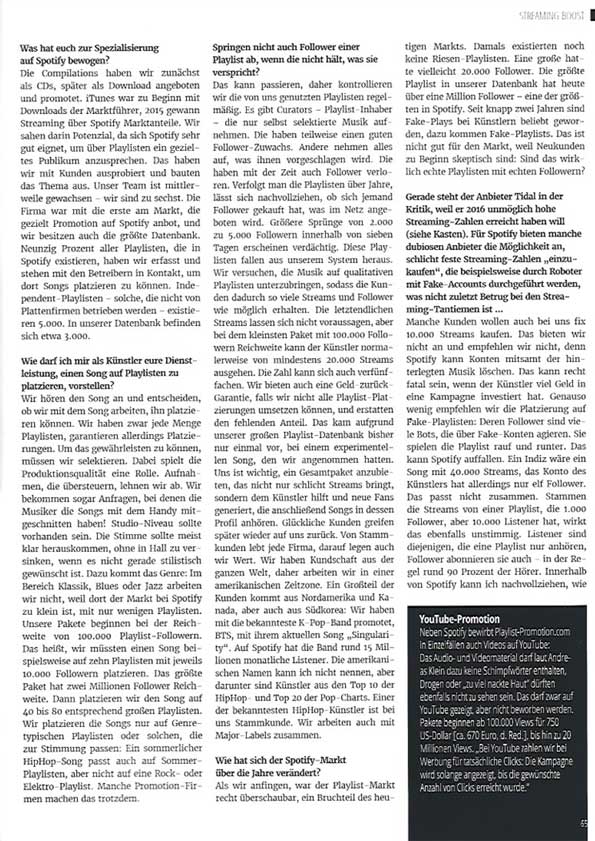
The provider Tidal is currently under criticism because it claims to have reached impossible high streaming numbers in 2016. For Spotify, some dubious providers offer the possibility to simply “buy” fixed streaming numbers, which are for example carried out by robots with fake accounts, which is not least a fraud in streaming royalties ….
Some customers also want to buy fixed 10,000 streams from us. We do not offer and do not recommend this, because Spotify can delete accounts together with the deposited music. This can be quite fatal if the artist has invested a lot of money in a promotion campaign. We also don’t recommend the placement on fake playlists: Their followers are many bots that act via fake accounts. They play the playlist up and down. Spotify can notice this. An indication would be a song with 40,000 streams, but the artist’s account has only eleven followers. It doesn’t add up. If the streams come from a playlist that has 1,000 followers but 10,000 listeners, this also looks inconsistent. Listeners are those who only listen to a playlist, followers also subscribe to it. Within Spotify I can track how many streams on my song come from which playlists. I can see how many followers the playlist my song is placed on has and how many listeners the playlist has. Another indication: Many fake playlists contain a lot of songs – for example 1.000 songs – but have only a few followers. The profiles of the fake playlists are also quite meaningless, for example a cryptic combination of letters and numbers as profile names. For Spotify it is not easy to prevent robots. They could insert a captcha verification – but of course the users don’t want to fill in a code every time they hear a song, apart from that: As an artist I usually want my music to be heard and people to enjoy it, I want to build a real fanbase, ‘What do I want with 10,000 robots? For the majority of these customers, it’s all about making a name for themselves to others, „I’m important!“
What is the relevance of playlists on Spotify compared to me as a user searching and listening to music?
Some people don’t necessarily look for a playlist, but they find it when searching for specific music. Playlists are popular because they make it easier to listen – they run through like a matching radio station. If I’m looking for a song, for example Billie Eilish’s hit “Bad Guy”, I’ll see playlists with similar music. Very few people want to listen to just one song and then search for the next one. As a user I would tap on the playlist, if I like it, I press “Follow”, otherwise I might listen to another one.
How can I imagine the average playlist owners?
These are mostly private persons, plus DJs, occasionally also magazines and labels. The biggest playlist owners started relatively early and probably did not have the intention to create a well-known playlist. This happened accidentally over time. I know many and have the impression that 60 to 70 percent of playlist curators are women. We have a large hip-hop playlist in the database that is curated by a woman in her early 20s in the Philippines. She hit a nerve with her taste and has generated hundred thousand real followers. Nowadays, it is more difficult to reach many listeners with a new playlist because many genres and niches are already covered. We have been in contact with the curators of the playlists in our database for quite some time now, and we maintain these contacts regularly. Pop and HipHop are the most popular – about the same amount – plus Rock and Electro. These genres are the focus of our clientele.
Do the owners profit financially from whom they accept “music suggestions”?
Partly. Many accept suggestions because they find the music good and exciting, because it is also their passion to edit and maintain playlists. They take pleasure in winning followers. It’s like in the past with people who like to create MixTapes! Some do it just for fun, others charge money for placing on their PIaylist. This can be a good extra income for those who attach great importance to their playlist, select well and work out the playlist continuously. The more listeners and followers a playlist has, the more they can charge.
You place with “free” playlists as well as with those owners who demand money?
Yes, sometimes we have no choice and have to pay for spotify playlist placement, we guarantee placements and success to our customers. The Spotify promotion packages are extensive, so we have to have something to show for it. Of course, artists could also approach playlist owners directly and offer a song, but it takes time to find suitable playlists and contacts and write to them – they would then have to follow up, as many contacts don’t respond to the first letter, and perhaps a fifth when following up. Whether they accept the proposal is still to be seen – the chance of success is much lower. Our advantage: We know the playlist curators for a long time, you know that we offer them only suitable music of which they accept the suggestions in 90 percent of the cases.
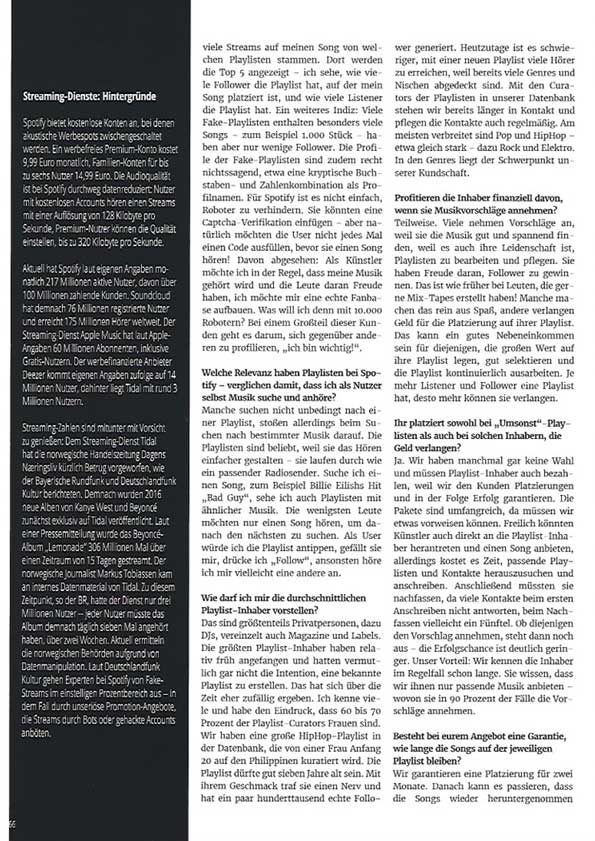
Is there a guarantee with your offer how long the songs will stay on the respective playlist?
We guarantee a placement for two months. After that it can happen that the songs are taken down again or stay on the playlist for months, years. That depends on the taste of the playlist owner. Some remove songs so that the playlist does not get too full. With a playlist the rule is: quality before quantity. In my opinion, a playlist should ideally have between 30 and 150 songs. A successful playlist in the genre “Classic 80s” could also contain 300 useful songs – but only if they are well selected.
What are your prices for this playlist pitching service?
We work in dollars, since the majority of our customers are from North America. The 100,000 package costs 350 US dollars (approx. 315 euros]. The package with two 2 million followers currently costs 4,900 US dollars [approx. 4,400 Euro].
The big promotion package will probably be booked less by newcomers who have just finished their first EP?
We do indeed have newcomers booking the package as it can be a good kick-start for a career. Spotify and YouTube promotion are in my opinion ideal opportunities for musicians because there is a return on investment and the target group is easy to narrow down. The most successful song we promoted on Spotify reached over six million streams. This means the band has earned three or four times their promotional investment. At least part of that money comes back.
How can I as an artist track the success of a booked spotify promotion campaign?
This can be measured by the streams and followers, which alone are visible on every mobile phone. On the page artists.spotify.com you can see how many of the streams came from which playlist. In addition, it shows how many people saved the song in their library and how many followers were added per day. After the end of the promotion campaign we send a report as a PDF file containing all playlists, links to playlists, number of followers and all other relevant data.
How should I as an artist promote my Spotify presence on the net?
Spotify behaves similar to Google: The more often a link is shared, the higher it rises in the internal ranking of the platform, I would post and add my Spotify link wherever possible, share as often as possible: On Facebook, below the YouTube video, in my own blog, on the website, in my Instagram stories and in WhatsApp groups. Tell friends to share the link. What I can also recommend:
Spotify has the most user-friendly interface. As an artist with my own website, I can add a Spotify player so that visitors coming to my website can stream Spotify music directly from my website. I can install that for free. Inside Spotify, I go to my album and click on “Copy embedded Code”, This HTML code that can also be inserted into blogs or WordPress pages. It can be used by everyone directly, even without Spotify registration – like a web player.
According to the music industry, the streaming market share has now caught up with CD sales. Apple has also heralded the end of iTunes, thus abandoning the most successful download model. Apple, on the other hand, continues to pursue the streaming market with Apple Music. How do you think Spotify will develop in the next few years?
I suspect that the music video market within Spotify will grow strongly. There are already a few music videos that are displayed with the songs. Partly as GIFs, which are played in a continuous loop, but the amount is still quite small.
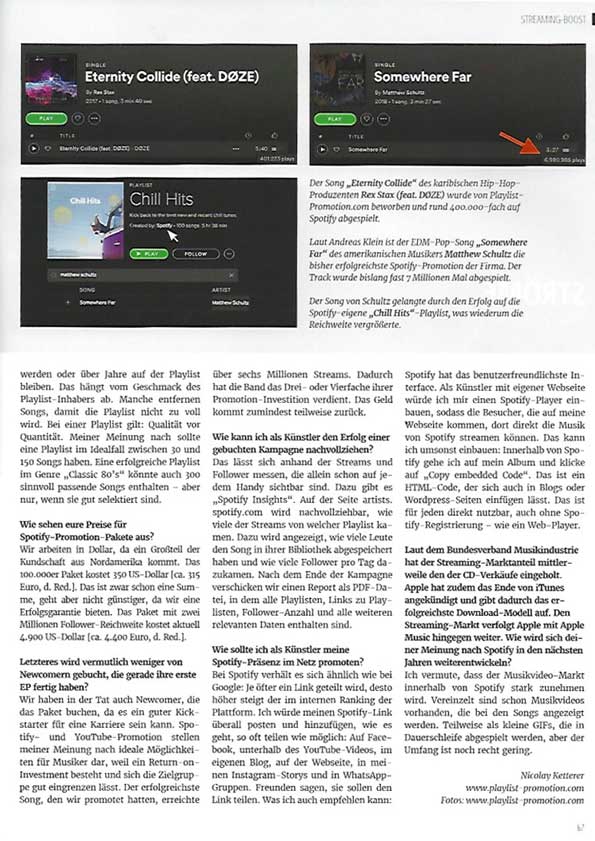
YouTube promotion
In addition to Spotify, Playlist-Promotion.com occasionally promotes videos on YouTube:
According to Andreas Klein, the audio and video material may not contain any violence, drugs or even too much “naked skin”. Although this may be shown on YouTube, it may not be advertised. Packages start from 100,000 views for 750 US dollars or 670 euros, up to 20 million views. “On YouTube, we pay for actual clicks when we advertise: The campaign will be shown until the desired number of clicks is reached.”
Web: https://synmag.de
Do you like this article? Share it with your friends.

It’s great to hear about your background in music marketing, booking, and DJing before Spotify, which I’m sure helped provide a solid understanding of the industry at large before you entered streaming – to great success.
With the extraordinary impact of streaming, it was a very wise choice on your part back in 2014.
16 years as a company is a phenomenal achievement, here’s to hoping for another 16 more at least! You guys certainly deserve it!
Moin Herr Klein,
ich bin Malte von der Insel Baltrum und wohne in Hamburg.
Ich hätte großes Interesse mit Ihnen eine Kooperation zu machen. Ich habe einen Social Media Account mit sehr großer Reichweite, über den ich das Listing auf Spotify Playlisten verkaufen könnte. Hätten Sie Interesse an einem B2B Geschäft? Ich würde mich sehr über eine Antwort freuen.
Liebe Grüße
M. Høyer